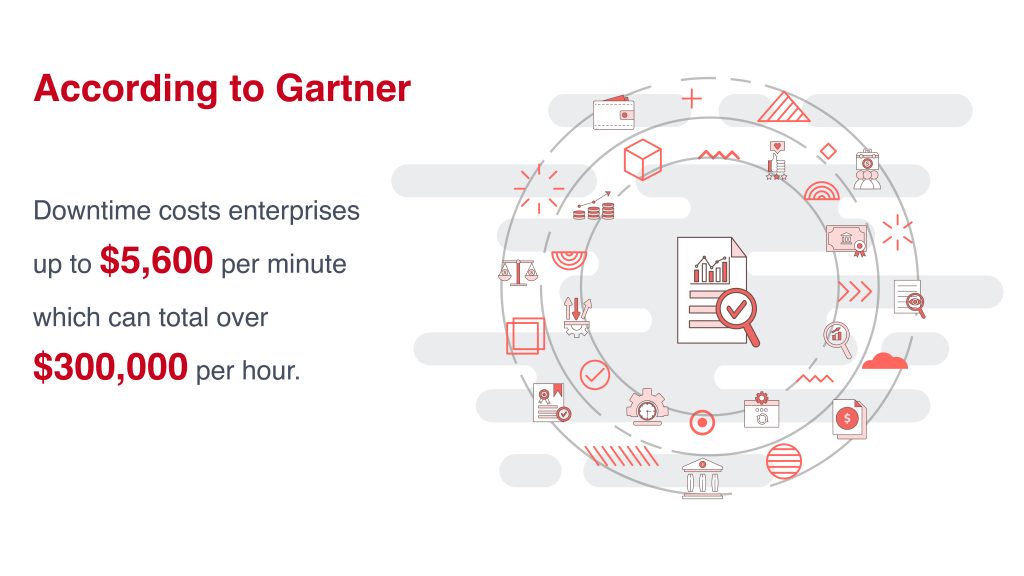When ‘Good Enough’ Becomes Business Risk
Imagine this scenario: you’re preparing for your annual 11.11 sale event. Months of marketing lead-up, warehouse prep, inventory checks – all set. But on sale day, your legacy data center hits capacity limits. Order confirmations fail, customer chats drop, and payments time out. Sales nosedive, customer frustration peaks, and your brand takes a hit.
Your data center may have served well before – but data starvation, security lapses, and scaling failures could be hiding just below the surface. When your system’s “good enough” stops being enough, it’s time to modernize.
Sign 1: Frequent Downtime and Performance Lags
Downtime is lost revenue, missed opportunities, and diminished customer trust.

Source: Gartner
Applications slow down, backups fail, and operations halt without advanced monitoring.
If backups regularly fail, alerts flood your inbox, and end-users complain of sluggish performance, your infrastructure stands in the way of success.
Sign 2: Rising Operational and Maintenance Costs
Legacy data centers aren’t just outdated, they’re prohibitively expensive to maintain.
Cooling systems degrade, UPS batteries fail, and emergency vendor pricing skyrockets for unscheduled fixes.
With predictive maintenance for data centers, you can integrate sensors and analytics to foresee faults, reducing outages, extending hardware life, and saving money over time.
Sign 3: Incompatibility with Modern Workloads
Modern workloads, AI/ML models, containerized apps, real-time analytics demand more than your old data center can deliver.
- Without 100GbE connectivity, GPUs can’t communicate fast enough for distributed AI workloads.
- Traditional VMs don’t support Kubernetes or microservices deployment, limiting agility.
- You miss out on AI-driven data center management, self-healing systems, and dynamic scaling.
If your data center can’t support hybrid, real-time, or data-intensive operations, competitors will outrun you.
Sign 4: Security Vulnerabilities
Every outdated component increases your security risk.
- Most breaches stem from legacy system errors or misconfigurations.
- Unsupported firmware, weak encryption, and unpatched vulnerabilities are open doors to attackers.
- Strict regulations like GDPR and HIPAA impose hefty penalties for non-compliance.
Modern data centers deploy zero-trust architecture, encrypted storage, and real-time threat detection to close these gaps.
Sign 5: Inability to Scale Quickly
Business scales fast. Your infrastructure must keep up.
- Legacy data centers require weeks to deploy new racks or network upgrades.
- Public cloud latency issues, cost unpredictability, and compliance constraints make it difficult to fully shift off-premise.
- Without hybrid options or modular design, your growth is siloed.
If capacity expansions take too long or cost too much, you’re locked out of opportunities.
Choosing the Right Partner
Modernizing your data center is a strategic initiative that directly impacts scalability, compliance, performance, and even talent retention. At the heart of that transformation is choosing a vendor who understands the demands of modern workloads – AI, edge computing, cloud-native applications and can offer resilient, scalable, and compliant infrastructure.
Here’s how to make an informed choice when navigating data center vendor selection.
Key Traits to Look for in a Data Center Partner:
- Proven experience in hybrid and AI-ready modernizations
Look for vendors with a portfolio of AI-driven data center management implementations, as modern workloads demand real-time analytics, automation, and workload orchestration across on-prem and cloud.
- Transparent pricing and flexible capacity planning
Avoid vendors with rigid contracts or unpredictable costs. Seek clear, tiered pricing models and support for rapid ramp-up or ramp-down of resources, especially relevant in colocation provider setups.
- Predictive maintenance capabilities
Modern data centers should be equipped with predictive maintenance for data centers, leveraging AI to reduce unplanned outages and proactively address system vulnerabilities.
- Compliance and security certifications
Ensure your partner has robust certifications such as SOC 2, ISO/IEC 27001, and PCI-DSS, and offers role-based access control, 24/7 monitoring, and audit-ready reporting tools.
- Disaster recovery & backup integration
A truly modern provider should integrate disaster recovery into the core design, offering backup replication across zones or geo-locations with defined RTO/RPO objectives.
Colocation Provider Checklist:
- SLA of ≥ 99.99% uptime
- Modular energy systems with Power Usage Effectiveness (PUE) transparency
- Certified physical and logical security (SOC 2, ISO 27001, etc.)
- Access to low-latency cloud interconnects
- Scalable resource pools (bare-metal, virtualized, private cloud)
- Tiered upgrade pathways to support AV system upgrades or AI-ready deployments
- Local NOC teams and escalation pathways for hands-on support
The right partner helps you shift the mindset from infrastructure upkeep to driving innovation and customer experience.
Quantifying the Benefits You Achieve
Modernizing your data center with the right partner unlocks measurable business benefits. Whether you’re overhauling an outdated setup or transitioning to a hybrid architecture, the gains are tangible.
Let’s break down the core impact areas:
1. Downtime Reduction
Legacy data centers suffer from frequent outages due to aging hardware, inefficient cooling, and poor failover planning. An upgraded setup with AI-driven monitoring and auto-failover capabilities can reduce unplanned downtime by up to 70%.
2. Performance & User Experience
With modernized infrastructure, you get faster compute times, seamless application access, and low-latency networking all of which enhance employee productivity and end-user experience. This is particularly crucial for organizations adopting AI-powered AV, real-time analytics, or smart AV technology.
3. Energy Efficiency
Outdated equipment draws significantly more power. New-generation data centers are designed with modular cooling, liquid-cooled racks, and AI-driven power management. Modern facilities reduce operational energy use by 30–40% compared to legacy systems.
4. Security and Compliance
Modern DCs come with built-in encryption, zero-trust access policies, and compliance by design, making audits smoother and security breaches rarer. With smart monitoring, real-time alerting, and voice analytics in UC platforms, threats are detected earlier and resolved faster.
5. Scalability on Demand
Upgrades enable you to scale infrastructure within hours, not months, thanks to cloud-connected architectures and software-defined provisioning. You’re no longer tied to physical deployments for each capacity bump.
ROI that Pays for Itself
While modernization may seem like a capital-heavy investment, the ROI of AV investments and data center upgrades becomes clear within 18 to 24 months. This is especially true when you’re supporting AI, cloud-native applications, or hybrid workforce tools that require 24/7 reliability.
Final Thought: Upgrade Now, Compete Tomorrow
If your infrastructure yields frequent downtime, high costs, security gaps, outdated capabilities, or slow scaling, it’s holding you back.
A modern approach delivers operational efficiency and performance,making your data center a business enabler, not a bottleneck.
Your next steps:
- Conduct an independent infrastructure audit
- Compare costs and benefits
- Design a phased modernization roadmap
- Partner with a vendor like Brilyant for implementation
Brilyant combines AI-driven data center management with hybrid-ready design, predictive maintenance, and compliance-first deployment.
Book your free Data Center Modernization Assessment now and turn your data center from a drag into a competitive edge.

More Articles
We are here to help
Get in touch with our in-house experts to find the right solution for your IT Infrastructure



